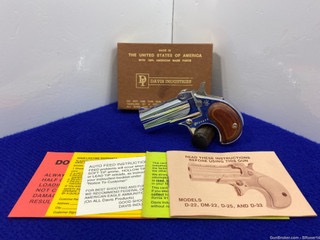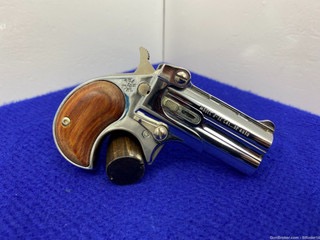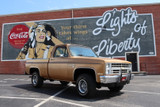*SOLD* Royal Small Arms Factory Enfield No. 2 .38 S&W *BRITISH SERVICE REVOLVER*
Bryant Ridge's Analysis
The Enfield No. 2 was a British top-break revolver using the .38 S&W round manufactured from 1930 to 1957. It was the standard British/Commonwealth sidearm in the Second World War, alongside the Webley Mk IV and Smith & Wesson Victory Model revolvers chambered in the same caliber. In the context of British service revolvers, the .38 S&W cartridge has often been called ".380" (no relation to the common modern .380 ACP pistol cartridge).
There were three main variants of the Enfield No 2 Mk I revolver. The first was the Mk I which had a full-spur hammer and was double-action/single-action, meaning the shooter could either thumb-cock the hammer before pulling the trigger or could pull the trigger with the hammer uncocked; some shooters preferred the latter option as the trigger pull is much lighter with the hammer cocked. The handgrips were made of wood. This version was made until 1939 when a change order introduced the Mk I*. About 55,000 Mk Is were made, and an unknown number were converted to Mk I* during factory repair, as required by the change order that created the Mk I*. See: Stamps, Mark, and Ian Skennerton, .380 Enfield Revolver No. 2 for further information.
The second variant was the Mk I*, which had a spurless hammer and was double-action only, meaning that the hammer could not be thumb-cocked by the shooter for each shot. Additionally, in keeping with the revolver's purpose as a close-range weapon, the handgrips, now made of plastic, were redesigned to improve grip when used in rapid double-action fire; the new handgrip design was given the designation Mk II. Most Enfields produced were either Mk I* or modified to that standard.
The vast majority of Enfield No 2 Mk I revolvers were modified to Mk I* during World War II, generally as they came in for repair or general maintenance; It is believed that the reason was that the Mk I* version was cheaper and faster to manufacture and allowed for far quicker training. When used in the manner British forces trained (rapid double-action fire at very close ranges), the No 2 Mk I* is at least as accurate as any other service pistol of its time because of the relatively light double-action trigger pull. It is not, however, the best choice for deliberately aimed, long-distance shooting — the double-action pull will throw the most competent shooter's aim off enough to noticeably affect accuracy at ranges of more than 15 yards (14 m) or so. Despite officially being declared obsolete at the end of World War II, the Enfield (and Webley revolvers) were not completely phased out in favor of the Browning Hi-Power until April 1969.
Specifications
Manufacturer: Royal Small Arms Factory (RASF) in Enfield
Model: Enfield No. 2
Serial: SRN667
Caliber: .38 S&W
Finish: Blue
Barrel Length: 5"
Optics/Sights: Pinned Patridge Blade Front with
Stock/Grips: Checkered Wood
Action: Top-Break; Double-Action
Markings: Standard
Images


Recent Posts
-
Museum-grade 1985 Chevrolet K10 4x4 SWB Outdoorsman
Hey, Squarebody Fans! Prepare for a jaw-dropping throwback at the Winchester Collectors Arms Show …Sep 4th 2025 -
Why You Should Consign Your Firearms with Bryant Ridge Co.
Why You Should Consign Your Firearms with Bryant Ridge Co.The Smart Choice for Your Guns! If you’r …Sep 4th 2025 -
Bryant Ridge's Featured Firearm of the Week: The King Ranch Cowboy's Dream!
Bryant Ridge's Featured Firearm of the Week: The King Ranch Cowboy's Dream! Get ready for a t …Sep 4th 2025



